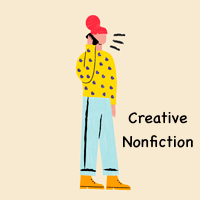"I killed a man before, you know."
It's 3:12 pm, an awkward time for us to be preparing food. I'm not sure if we're making a late lunch, an early dinner, or just afternoon tea. I've been
...
[+]
A fashion show would quickly ensue as we picked our favorites from the bounty. With layers of graphic tees and braided belts, we would parade down the hall to crowd around the long mirror hanging from my parents’ closet. All eight of us perusing for every item that was near our size and wasn’t completely hideous. Neon green shirt with black and purple stripes? Definite no. Dress with little lilac flowers? Really cute, but a little long. Maybe if we hemmed it? Leather trench coat? Hmm... maybe not? We would continue like this until we had all selected our loot and were satisfied with the pillage.
The summer before fourth grade, the jolly old fellow out did himself. I can still see it in my mind, captured in a polaroid of memory—a pink corduroy jacket with purple and yellow daisies appliqued up the sleeves. St. Nicolas must have plucked it from the hands of a hippie-fairy. It was the jacket of my dreams. Absolutely perfect, except for the tear on the right cuff. I wore the jacket to the first day of school anyway, pulling the sleeve tight and clutching the cuff so no one would notice the rip. With my hair in dutch braids and my faded yellow converse—also selected from the magical black bag— I bounced to the monkey bars, thinking that my awesomeness at this moment demanded that everyone must play with me, even the snooty girls who traded soda-flavored lip balms during recess.
No one could deny the corduroy jacket.
Or so I thought, until Sabrina Cook sauntered over with her Dr. Pepper lips and ordered that I show her the tag inside of my coat. She claimed the jacket was hers, until her mother placed it in a bag to be sent to the “needy and impoverished.” I, of course, protested. This jacket was a gift, and I was not “needy and impoverished” or whatever she said. But to my absolute horror, the evidence of faint purple sharpie, spelling Sabrina on the tag, suggested otherwise. So, after learning from my teacher that impoverished means “a state of poverty”, I went to the bathroom to cry and to contemplate my new discovery –Santa was not real! Also, I was living in poverty, but Santa wasn’t real!
What I didn’t discover that day is that there is a line—the poverty line— drawn somewhere on the constructs of society, that decides your inclusion as a member of the impoverished. A line that defined my life much differently than I thought as a nine-year-old. Poverty doesn’t look like hand-me-downs in a black trash bag or reusing your aluminum foil till the crinkles become cracks. It doesn’t look like watered down soup from the night before, or dark circles under my father’s eyes. This is not the picture of poverty.
Poverty looks like the leathered hands of the homeless man on elm street, twisting torn plastic bags into blankets. It looks like a watery bowl of rice with only salt as a topping, scooped from bowl to mouth in hurried swipes. It’s seen in the empty eyes of a mother holding her baby close while they sleep in the back of a car. No, I cannot claim to be a portrait of poverty. I have not lived beneath that line.
I fit somewhere in the stretch of miles between the impoverished and the prosperous. The problem is, this stretch of land is wide and encompasses many levels of struggle; all lumped into one sum category we call “poor”. In this way, I feel the English language has abandoned me, leaving others to conjecture at my meaning when I say I know the feeling of being poor. Or maybe what I’m feeling is pride, poking and prodding for validation that poor can mean more than just packets of ramen. There are many polaroids of poor that I’ve collected over the years, and they are not equal.
Sometimes poor looks like an old car with the fender dragging, slapping the highway anytime you go over 40. Other times, poor looks like tender feet, sore from walking 7.25 miles to work, standing an eight-hour shift, and then making the return trip. Poor can look like slowly saving pennies to finally buy that pair of shoes. But it can also look like hole-ridden soles, because the pennies just aren’t there. Some days poor looks like falling into bed after a thirteen-hour day, soaking in cherished sleep before you start again. On bad days, poor looks like sitting at home wringing your hands, praying the phone will ring with news of an interview.
And so it goes, the polaroids of poor that I’ve collected. I plaster them on the walls of my memory with gold striped washi tape and create a montage of meaning. Meaning lacking from the single four-letter word that English has tasked with describing a myriad of human experience. And at the center, is a faded picture of a pink corduroy jacket with purple and yellow daisies appliqued up the sleeves.



